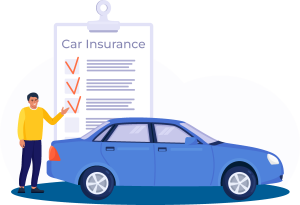In a rapidly changing world, new technologies are changing every aspect of our lives, and the insurance industry is no exception. Car insurance is an important part of owning a car and it is changing. As we enter the digital age, new ideas are constantly emerging to transform services and improve the entire customer experience. This article discusses the most advanced car insurance options that will change the way we protect our cars and ourselves on the road.
1. Usage-based Insurance (UBI):
The introduction of usage-based insurance (UBI) is one of the most significant changes in the history of auto insurance. UBI uses telematics technology to monitor and evaluate a person’s driving behavior. Insurers can tailor rates to each driver’s actual risk profile by collecting real-time data on speed, acceleration, braking, and time of day.
This personalized approach not only encourages safer driving but also helps responsible drivers save money on insurance. With UBI, insurance companies could offer lower premiums to people who do not behave in a way that poses a risk. This is a good thing for both insurers and policyholders.
2. Blockchain Technology for Enhanced Security:
Adding blockchain technology to the insurance industry will help solve many problems, such as preventing fraud, keeping data safe, and being open and honest. Because the blockchain is decentralized and difficult to change, all transaction data is kept secure. This reduces the risk of false claims and builds trust within the insurance community.
Smart contracts allow insurance companies to speed up and automate the claims process, making the customer’s job easier. Settlements are faster and operating costs decrease, allowing insurance companies to offer lower rates.
3. The Use of AI to Process Claims:
Artificial intelligence is changing the way car insurance cases are handled. Artificial intelligence algorithms can quickly and accurately look at large amounts of data, speeding up the claims review process. This speeds up the process of getting a claim approved, making it easier and less stressful for consumers.
In addition, bots powered by artificial intelligence are also used to answer customer questions and provide immediate assistance. This not only makes customers happier but also frees up staff to complete more difficult tasks, making insurance services faster and more efficient.
4. Peer-to-peer Insurance Network:
Peer-to-peer (P2P) insurance networks are shaking up the standard way of thinking about insurance. P2P insurance allows people with similar risk profiles to pool funds and resources to form a self-insurance community. When members work together in this way, there is a sense of greater trust and openness.
P2P networks can use blockchain technology to automatically allocate premiums and claim payouts, reducing the amount of work administrators have to do. Additionally, the community portion encourages everyone to drive safely, further reducing everyone’s risk.
5. Parametric Insurance Enables Fast Payouts:
When people have traditional insurance, the claims process can take a long time, which can leave them in financial trouble when times get tough. However parametric insurance is a new approach to the problem because it pays out based on predefined parameters rather than actual losses.
For example, if a car is damaged by severe weather, a parametric policy may pay out based on the severity of the weather rather than the exact damage caused. This fast and automated payment system ensures that customers receive their money quickly, giving them peace of mind in difficult times.
6. Cybersecurity Coverage for Connected Cars:
As cars become more connected, cyber threats targeting smart cars become increasingly likely. New auto insurance policies address cyber threats specific to internet-connected vehicles. This ensures that customers are protected not only from physical damage to their car but also from cyber-attacks that could reduce the safety and usability of their car.
By covering the specific risks of smart cars, insurers stay ahead of the curve and provide comprehensive coverage to keep pace with changes in automotive technology.
Conclusion
Insurance options to protect car owners must change as the cars themselves change. This article discusses the next generation of auto insurance solutions that are a huge step towards more personalized, efficient, and technologically advanced insurance. Insurers can transform the way they serve their customers by using new technologies such as usage-based insurance, blockchain, artificial intelligence, peer-to-peer networks, parametric insurance, and cybersecurity coverage. This makes driving safer for everyone. As we move into the future, these innovations have the potential to change the way auto insurance works and set new standards for quality and creativity.
FAQs
1. What does usage-based insurance (UBI) mean?
Usage-based insurance (UBI) is a new way of thinking about car insurance that uses telematics to track and evaluate how each drives. Insurers can tailor rates to each driver’s actual risk profile by collecting real-time data on speed, acceleration, braking, and time of day. This personalized approach can help responsible drivers save money on insurance and make them safer drivers.
2. How does blockchain technology make car insurance more secure?
Blockchain technology makes car insurance more secure by storing transaction data decently and immutably. In the insurance ecosystem, this makes things clearer and reduces the chance of false claims. Blockchain smart contracts accelerate and automate the claims process. This means faster payments and lower administrative costs.
3. What changes will artificial intelligence (AI) bring to car insurance?
Artificial intelligence is transforming auto insurance by quickly analyzing data to speed up the case process. AI-powered algorithms can assess claims quickly and correctly, giving policyholders less to worry about and getting their claims approved faster. AI-powered chatbots can also be used to assist customers immediately, increasing efficiency and customer satisfaction.
4. What is a peer-to-peer (P2P) insurance network?
Peer-to-peer (P2P) insurance networks bring together people with similar risk profiles to share resources and build a confident community. Blockchain technology is often used to automate claim payments and premium distribution. This creates trust and openness among the members. P2P networks make driving safer for everyone and encourage responsible behavior.
5. Explain what parametric insurance is and how it works.
Parametric insurance pays out based on set parameters rather than actual losses. For example, if severe weather damages a car, a parametric policy can pay out based on the severity of the weather, regardless of the specific damage. This approach ensures that transfers happen quickly and automatically, making money available quickly when people need it most.
6. Why is cybersecurity for connected cars important?
Smart cars need cybersecurity to protect against growing cyber threats. Vehicles can be vulnerable to hackers, who can reduce their security and usability as they become more connected. Auto insurance plans of the future will cover cyber threats specific to connected vehicles, providing policyholders with adequate security.


